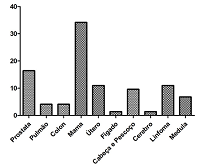Manifestaciones orales en pacientes sometidos a quimioterapia.
Palabras clave:
salud bucal, quimioterapia, cáncer.Resumen
Introducción: la quimioterapia es un tratamiento basado en el uso de fármacos anticancerígenos que inducen la muerte de las células cancerosas. La literatura describe lesiones bucales pueden surgir como resultado de la quimioterapia.
Objetivo: identificar las manifestaciones bucales en pacientes sometidos a quimioterapia atendidos en el servicio de referencia en oncología en Estado del Ceará - Brasil.
Materiales y Métodos: se evaluaron 73 pacientes afectados por algún tipo de malignidad tratada con quimioterapia a partir de enero de 2013 hasta el mes de diciembre del 2014. Los datos clínicos y patológicos, como la edad, el sexo, el diagnóstico de malignidad, tipos de tratamientos con fármacos de quimioterapia contra el cáncer, entre otros, se obtuvieron de los registros médicos. También se llevaron a cabo exámenes bucales en todos los sujetos de este estudio por el experto en estomatología.
Resultados: de los 73 pacientes 29 (39,7%) eran hombres y 44 (60,3%) mujeres, con una edad media de 57,7 años, y 37 (50,7%) eran fumadores. La mayor prevalencia del cáncer se observó en la mama (35,6%). Los fármacos más frecuentemente utilizados en el tratamiento de quimioterapia fueron aredia en 23.3% de los casos (n = 17) y paclitaxel en el 17,8% (n = 13). En relación a las enfermedades bucales, de los 73 pacientes estudiados, 44 (60,2%) tenían algún tipo de malestar bucal La mayoría de los pacientes, el 77,3% (n = 34) fueron diagnosticados con xerostomía y el 22,7% (n = 10) con mucositis.
Conclusión: las lesiones bucales que se encontraron en los pacientes sometidos a quimioterapia fueron a xerostomía y mucositis. La xerostomía fue la condición patológica bucal más frecuente.
Descargas

Publicado
Cómo citar
Número
Sección
Licencia
Los autores conservan todos los derechos sobre sus obras, las cuales pueden reproducir y distribuir siempre y cuando citen la fuente primaria de publicación.
La Revista Cubana de Estomatología se encuentra sujeta bajo la Licencia Creative Commons Atribución-No Comercial 4.0 Internacional (CC BY-NC 4.0) y sigue el modelo de publicación de SciELO Publishing Schema (SciELO PS) para la publicación en formato XML.
Usted es libre de:
- Compartir — copiar y redistribuir el material en cualquier medio o formato
- Adaptar — remezclar, transformar y construir a partir del material.
La licencia no puede revocar estas libertades en tanto usted siga los términos de la licencia
Bajo los siguientes términos:
- Atribución — Usted debe dar crédito de manera adecuada, brindar un enlace a la licencia, e indicar si se han realizado cambios. Puede hacerlo en cualquier forma razonable, pero no de forma tal que sugiera que usted o su uso tienen el apoyo de la licenciante.
- No Comercial — Usted no puede hacer uso del material con propósitos comerciales.
- No hay restricciones adicionales — No puede aplicar términos legales ni medidas tecnológicas que restrinjan legalmente a otras a hacer cualquier uso permitido por la licencia.
Avisos:
- No tiene que cumplir con la licencia para elementos del material en el dominio público o cuando su uso esté permitido por una excepción o limitación aplicable.
- No se dan garantías. La licencia podría no darle todos los permisos que necesita para el uso que tenga previsto. Por ejemplo, otros derechos como publicidad, privacidad, o derechos morales pueden limitar la forma en que utilice el material.

